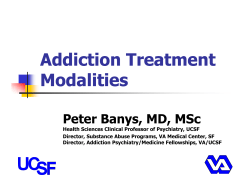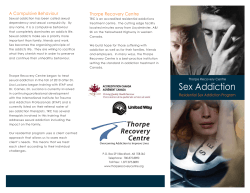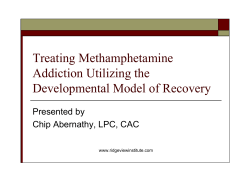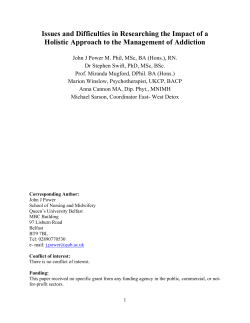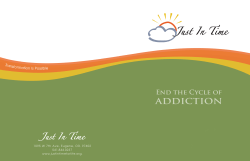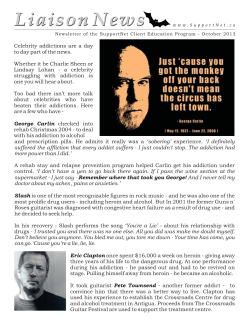
Document 184408
Helping persons with addiction: 2
Alcohol, drug misuse and other addictions:
What to know
and
how to get help
National Institute of Mental Health and Neuro
Sciences
(NIMHANS)
De-Addiction Centre
2009
1
Front inner cover
Title: Alcohol, Drug Misuse and other Addictions: What to know and how to get help.
Copyright: De-Addiction Centre, NIMHANS, Bangalore
ISBN:
This booklet is produced by the De-Addiction Centre, NIMHANS. It is based on
educational material compiled from different sources primarily for the information
kiosks. These kiosks, introduced in 2007, are intended to provide information to the
general public, persons with addiction related problems and their family members.
Inputs for this booklet have been provided by the staff of the De-Addiction Centre:
E Sinu Dasan, Psychiatric Social Worker
Srijayan, Senior Resident
Muralidharan K, Senior Resident
Arun Gupta, Senior Resident
Bala Shanti Nikketha, Psychiatric Social Worker
Imran Khan, Psychiatric Social Worker
Vanitha C, Psychiatric Social Worker
Dhanasekara Pandian, Assistant Professor of Psychiatric Social Work
Deepa Shankar, Clinical Psychologist
Manoj Sharma, Assistant Professor of Mental Health and Social Psychology
Suman Rao, Associate Professor of Mental Health and Social Psychology
Prabhat Kumar Chand, Assistant Professor of Psychiatry
Vivek Benegal, Additional Professor of Psychiatry
Pratima Murthy, Professor of Psychiatry
Illustrations:
Vivek Benegal, Additional Professor of Psychiatry
*Some of the illustrations have been downloaded from the internet.
Our hearfelt thanks to all our nursing staff who have given valuable insights into
inpatient care, to our patients, many of whom have provided a feedback for the draft
versions of this booklet and to Ms Geeta Krishnan for secretarial assistance.
We gratefully acknowledge the support of Dr D Nagaraja, Director and ViceChancellor, NIMHANS.
2
(back inner cover)
NIMHANS
A Short History
The De-addiction Centre at NIMHANS was established in 1991. In 1998, the NIMHANS
De-Addiction Centre was recognized as the Regional Centre for the Southern Region by
the Ministry of Health and Family Welfare, Government of India.
A separate building was commissioned in 2002.
It has now expanded into a 58 bedded centre.
Services provided at the Deaddiction Centre
Assessment of the drug/alcohol use problems
Detoxification
Pharmacotherapy
Individual counseling
Group therapy
Treatment for associated medical and psychiatric illness
Services provided at the deaddiction centre for families of substance users
Brief counseling sessions in the outpatient department.
Intensive family sessions that focus on:
o The impact of substance use
o Strengthening coping strategies
o Helping to support abstinence
o Behavioral modification in terms of communication, role functioning and
reinforcement
o Group work for family members.
o Pre discharge counseling for the family members.
o Home visits
o Assessment of children
Outreach services
We have provided services and models of care for NGOs and workplaces in evolving substance
use prevention programs
Research from the center has focused on
Extent of alcohol and drug problems in the community (Epidemiological research)
Examining brain changes in persons with high vulnerability to addiction (Imaging
and electrophysiological)
Treatment and Outcome studies
Training programs include
Training of post-graduates in medicine and mental health
Workshops/Seminars/Symposia at regional, national and international levels
3
Regular training on substance use management to medical and other health professionals
4
Drugs of abuse: What are they?
What are drugs of abuse and how do they affect people?
A drug of abuse refers to any drug that alters mood or body function that can be habitforming or addictive
People generally use drugs because they like the way drugs make them feel
Pleasure is a powerful force
If one does something pleasurable, the brain is wired in such a way that one wants to do it
again
A person has control over his/her choice to start using drugs, but once started, the pleasurable
effect of drugs makes one want to keep reusing
Over time, the brain actually changes in certain ways that the powerful urge to use drugs
controls the persons‘ behavior.
This is what it means by addiction.
Someone who is addicted uses drugs without thinking or caring about the consequences
Drugs that alter the mind and behaviour can cause problems even before addiction develops
WHY DO PEOPLE START?
1.Curiosity And Peer Pressure
2. Myths About Beneficial Qualities Of Alcohol
And Drugs
3. Imitation and Learning From Others
5
How do drugs cause problems?
By their behavioural effects
o intoxication
o removal of inhibition
o impairment of memory
o loss of control over one‘s action
o tendency to take risks under influence
By leading to addiction
What is addiction?
Addiction is a chronic, relapsing disease characterized by
compulsive drug seeking and abuse and by long-lasting chemical
changes in the brain
It is a state of being dependent on a substance, which is harmful
or dangerous for the physical and/or mental health of the person
and for his social and economic well-being
All drugs of abuse affect the brain
Addiction is a brain disease
Though each drug is different, the effects on the brain are
common
There is a circuit in the brain called the ―reward pathway‖
which releases a chemical called dopamine when stimulated
Release of dopamine causes the person to experience
pleasure
All addictive substances affect this circuit directly or indirectly
Long term effects on brain
Prolonged drug use causes
permanent changes in brain
structure and function that persist
even years after the person stops
taking the drug
Hence there is always a risk of
relapse even after many years of
stopping the drug
What is behavioural addiction?
Some activities which may be normally performed some times become so excessive that
they have features similar to that of substance addiction
6
Normal behaviors become addiction when:
o They increase and become repetitive
o The person gradually gets preoccupied with these activities neglecting his/her
other aspects of life
Is continued drug abuse a voluntary behavior?
The initial decision to use is voluntary; however, a person's ability to exert self
control later becomes impaired
Brains from drug-dependent individuals show changes in areas that are needed for
judgment, decision making, learning memory and behavior control
These changes alter the way the brain works, and may explain the compulsive and
destructive behaviors of addiction
Why do some people become addicted and others do not?
As with any other disease, vulnerability to addiction differs from person to person
In general, the more risk factors an individual has, the greater the chance that taking
drugs will lead to addiction
"Protective factors‖ reduce a person's risk of developing addiction
No single factor determines whether a person will become addicted
The overall risk is influenced by:
o Genes
o Gender
o Ethnicity
o His or her developmental stage
o The surrounding social environment (e.g., conditions at home, at school, and in
the neighborhood)
What environmental factors increase the risk of drug abuse and addiction?
Home and Family
Friends and School
Starting to use at young age
Method of use: Smoking a drug or injecting it into a vein increases its addictive
potential
Addiction is a developmental disease - it typically begins in childhood or adolescence
Can I be treated of addiction?
o Scientific research into addiction, has led experts to conclude that addiction is
treatable chronic disease, like diabetes or hypertension
o Like these disorders it is chronic and relapsing
o It requires long-term work to recover from addiction, and relapse is common
o The changes in brain persist long after drug use is stopped
7
o ―Cure‖ is therefore not necessarily an attainable or appropriate goal.
o In this respect, medically, addiction is more like hypertension -- which may require
long-term treatment with medication and lifestyle changes, and which often recurs –
rather than like fever, which gets cured and is forgotten
How does treatment help?
o Timely counseling and treatment help to arrest the progression of the disease
o It allows the person to have improved functioning and a good quality of life
o It helps to anticipate and effectively deal with lapses and prevent a lapse from
becoming a relapse
What are the treatment methods?
Treatment consists of
o Assessment
o Medications
o Individual Counseling
o Family Counseling
o Group Therapy
o After care
8
ALCOHOL
o It is the most widely used substance in the world, and has been for thousands of years
o Alcohol is a potentially addictive substance.
Types of alcohols in India
o Indian Made Foreign Liquors‘ [IML] – Whisky, Brandy, Rum, Vodka, Gin etc.
manufactured in India
o Beers of different strengths and wine
o Country liquor – manufactured in government-licensed factories, commonly called
‗arrack‘
o Illicit drinks are illegal, but consumed widely. Examples are toddy, mahua and chang
o Methanol is the most dangerous adulterant in illicit alcohol and is often the cause of
life threatening ―hooch tragedies‖
How does alcohol act
o Alcohol depresses the normal functions of the brain. At first it depresses the part of
the brain that controls inhibitions.
o In small amounts: seems to calm down and relieves anxiety
o In higher doses: talkativeness, boisterousness
o At even higher doses: increased sedation, loss of control and balance
o And finally: unconsciousness, coma and even death.
Effect of alcohol on health
Alcohol consumption has
o numerous health and social consequences
o is an important contributor to death and disability
o affects most of the organs of the body
o Worldwide, alcohol causes 1.8 million deaths each year
Cirrhotic liver
Consequences of alcohol drinking
9
Consequences of intoxication
o Motor vehicle crashes. Alcohol complicates diagnosis of trauma-related injury, may
mask or mimic the signs of a head injury and complicate treatment
o Workplace accidents
Enlargement of heart due to alcohol consumption
How does alcohol cause addiction?
o Alcohol like other addictive substances, activates and affects the brain's pleasure
circuit.
o Over time, the brain actually changes in certain ways so that a powerful urge to use
alcohol controls the persons‘ behavior.
Withdrawal symptoms
Coarse tremors of hands, tongue or eyelids later
Nausea/ vomiting
Malaise/ weakness
Increased pulse
Sweating
Elevated blood pressure
Anxiety
Depressed/ irritable mood
Headache and sleeplessness
Sometime one could have severe withdrawal and may have
Fits
Disorientation
Hallucinations,
Illusions and delusions
Social problems
o marital disharmony and domestic violence
o neglect of children
o criminal behaviour such as driving offences, breach of the peace, shoplifting
10
o unsafe sex
o financial problems
Family problems
―Alcohol destroys the home much before it destroys the liver‖
Occupational problems
o Poor work performance,
o Absenteeism
o Poor relationship with colleague
o Discipline problems
o Loss of job
o Industrial losses
o Losses to society
Does alcohol have protective
properties?
o Incidence of heart disease in
those who consume moderate amounts
of some kinds of alcohol (an average of 1 to 2 drinks per day) has been shown to be lower
than that in nondrinkers in some countries
o However with increased consumption the bad effects on health are many more and serious
o For the person beginning to drink alcohol, alcohol addiction and alcoholism is a real threat
and it is NOT advisable to issue guidelines that may lead some persons to increase intake of
alcohol or start drinking if they do not already do so.
11
Can one use without getting hooked?
o It would be ideal if the drug
user can carefully balance the
use of the more addictive
drugs
without
becoming
dependent on them.
o Getting hooked on a drug
usually has two aspects:
o Psychological
dependency
or
craving
o Physiological
dependency
o It is impossible to specify the levels of drug use to avoid psychological dependency, or
the 'craving' for a drug.
o Each individual has different levels of drugs when he would develop craving or
withdrawal
o Unfortunately, it is not possible to give more accurate information on this for all users.
Factors that would decide are:
o Body weight
o Strength of the drug
o Way it is used
o Situations it is used in
o Variations from person to person on how easily their body adapts to the drug.
Controlled use not possible for all
o Most users find they cannot keep to just weekend use and may find their drug use spiraling
out of control again, and abstinence may be the only long-term solution.
o Others may manage to only control their use until the next life crisis comes along.
The treatment of alcohol dependence includes
o Detoxification
o Medications to Decrease Craving
o Management of Relapse,
o Group Therapy
o Family Counseling
12
BEHAVIOURAL ADDICTION
What is behavior addiction?
Some activities which are normally performed may some times become so excessive that
they have features similar to that of substance addiction
Normal behaviors become addiction when:
o They increase and become repetitive
o The person gradually gets preoccupied with these activities neglecting his/her
other aspects of life
How are behavioral addictions similar to substance addiction?
Behavioral addictions have similarities with substance dependence like :
Recurrent failure (pattern) to resist impulses to engage in specific behavior
Frequently engaging in these behaviors to a greater extent or over a longer period of time
than intended
Persistent desire or unsuccessful efforts to stop, reduce, or control these behaviors
When does a normal behavior become addiction?
A normal behavior would become an addiction when there is:
o Continuing the behavior despite knowing that it is causing harm
o Need to increase the behavior to achieve the same pleasure as before
o Giving up or your social life,work and resposibilities because of the behavior.
o Distress, anxiety, restlessness, or irritability if unable to perform the behavior
Gambling
Sex addiction
13
BENZODIAZEPINES
What are benzodiazepines?
o Class of drugs familiar as sleeping pills
or minor tranquilizers
o Only available on doctors prescription,
usually given for treatment of
sleeplessness, anxiety disorders
Brand names of common benzodiazepines
o Calmpose, Valium (diazepam )
o Clonotril, Lonazep, Zicam (clonazepam)
o Alprax (alprazolam)
o Librium (chlordiazepoxide)
How do they act on the brain?
o Are brain depressants and induce
sleep
o Act on specific brain regions and lead to chemical changes in the brain
o At lower doses they cause feeling of pleasure
o In higher doses they can depress the areas of brain related to breathing and can cause
death
How do they cause addiction?
o They act of certain areas in the brain and effect the functions of the brain
o Finally they release the chemical dopamine at the pleasure circuit and the person feels
good
o The person is motivated to continue the drug for these pleasurable effects
o Later on he requires higher dose to get the same effects and may be using doses that
are lethal to another person.
What are the signs of intoxication ?
o Drowsiness
o Tremors
o Nausea
o Vomiting
o Difficulty in walking
o In excessive doses can cause coma and
death
What are the withdrawal signs?
o Sleeplessness
o Tremors
o Body aches
o Irritability
o Lack of interest in activities
o Tension and worries
14
o ―fits‖ if stopped suddenly
Medical problems on repeated use
o Sleep disturbance
o Seizures
o Toxicity with overdose of the drug
15
CANNABIS
It is a common psychoactive substance used widely.
It is obtained from the plant cannabis sativa
How is cannabis used?
Commonly used forms are
Marijuana or ganja: The leaves and flowering
tops of female plant
Hashish or charas: Concentrated resin
Bhang: A beverage prepared by grinding
cannabis leaves in milk and boiling with spices
and other ingredients
Hash oil: An highly concentrated oily mixture
These forms are either eaten smoked or vaporized
Cannabis contains a chemical Δ9 tetra hydrocannabinol that affects the brain and like other
substances finally is release of dopamine at the ―pleasure centers‖ and continued use causes
dependence
What are the immediate effects of using cannabis?
Initially cannabis causes a feeling of relaxation
In Higher doses it causes
Behavioral problems
Dry mouth
Increased heart rate
Red eyes
hallucinations and sensory distortions
Nausea and vomiting
What are the features of cannabis withdrawal?
Irritability,anger
Anxiety
Physical tension ,restlessness
Decreases in appetite and mood
Decreased body weight
Shakiness and sleep problems
Withdrawal first appear within 24 hours,most pronounced for the first 10 days and can
last up to 28 days.
How is cannabis harmful to health?
o Cannabis contains more tar than tobacco, and has a higher concentration of cancercausing agents
o With more tar smoking cannabis presents the same health problems as tobacco:
bronchitis, emphysema and lung cancer.
o It can disrupt the control of blood pressure increasing the risk of fainting
o Many people use cannabis initially and then switch to more dangerous drugs
o Cannabis can cause psychosis in people who are predisposed
Cannabis has been used as medicine too
Cannabis is used for some illnesses like
16
Cancer: To suppress nausea brought on by chemotherapy
AIDS: To increase appetite and prevent weight-loss
Glaucoma: an eye condition resulting in increased eye pressure
Severe muscular spasm.
What are the treatment available for cannabis addiction?
o Medications are given to control the withdrawal symptoms
o There are no specific medications to control craving
o Individual Counselling
o Group Therapy
o Family Counseling
o Treating the psychiatric disorder like psychosis if present
17
OPIOIDS
What are Opioids?
o Opioids are natural or synthetic derivatives of
poppy plant
o Used from time immemorial for a variety of
medicinal and recreational use.
What are different kinds of Opioids?
o Natural – opium, morphine and codeine
o Semi-synthetic - heroin
o Fully synthetic – pethidine, methadone.
Commonly abused Opioid medications
o Called prescription narcotics
o Include morphine, pethidine,
pentazocine, dextropropoxyphene,
codeine
o Codeine and diphenoxylate (Lomotil) are used to relieve coughs and diarrhea
How do Opioids act on the body?
o Act on the brain and body by attaching to specific receptors
o Block the sensation of pain
o Produce drowsiness, nausea, constipation
o Can depress respiration in high doses
o Give feeling of high
How do they cause addiction?
o Once started these drugs cause specific changes in the brain chemical balance
o Person gets pleasure on use for the first time, uses repeatedly and gets hooked
18
What are signs of intoxication?
o A ("rush") accompanied by a warm flushing of the skin, a dry mouth, and heavy
extremities.
o Following this the user goes into an alternately wakeful and drowsy state.
o May become confused with higher doses.
What are signs of withdrawal?
o Watering from the eyes
o Loose stools
o Pain abdomen
o Strange feeling in the skin
o Sadness and mood changes.
o Sleep reduction
o Body pains
o Vomiting
When does withdrawal start?
o Within few hours after the last
administration of substances such as heroin
o Peak between 48 and 72 hours after the last
dose and subside after about a week.
o Sudden withdrawal by heavy user may be life threatening
o Moderate withdrawal signs may last longer
Medical problems due to opioid use
o Chronic intravenous heroin users may develop collapsed
veins
o Infections of the heart
o Liver disease
o Pneumonia
o Sharing needles can cause AIDS and hepatitis
o Severe scarring due to injecting heroin intramuscularly
o Infection of heart due intravenous injections
What are the treatments available?
Assessment
Inpatient or outpatient treatment
Detoxification
Maintenance treatment
individual counseling
Group therapy
Family counseling
19
TOBACCO
What are the contents of cigarette?
Cigarettes contain more than 4000 chemical compounds and at least 400 toxic substances .
How does tobacco cause addiction?
o Once inside the brain, nicotine, like most addictive drugs, triggers the release of
chemicals associated with euphoria and pleasure.
Addiction: Both chemical and behavioral
o Like other substances finally there is release
of dopamine at the ―pleasure centers‖ and
continued use causes dependence
o In addition to chemical effects, experience
of holding and lighting a cigarette or bidi,
associating a smoke with coffee, alcohol or
food, can maintain the habit
W
20
hat are the problems with tobacco?
Symptoms of nicotine withdrawal
o Irritability
o Impatience
o Hostility
o Anxiety
o Depressed mood
o Difficulty concentrating
o Restlessness
o Decreased heart rate
o Increased appetite or weight gain
How soon do withdrawals start and how long do they last?
o The effects of nicotine withdrawal are different for each person.
o In general, the symptoms start with in a day of quitting are worst during the first few
days after quitting use of tobacco.
o The symptoms gradually get better over the next few weeks or months.
o Most people no longer feel the effects of withdrawal 6 to 8 weeks after quitting
Health impacts
Smoking effects most of the organs of our body
21
Changes in lung due to smoking
22
Smoking increases the risk of heart attacks
Quitting Tobacco Use
o A few people can stop smoking tobacco use themselves however most others need
professional help.
o Professional help includes:
o A detailed assessment
o Counselling
o Medication
o Some may require additional therapy
23
VOLATILE SOLVENTS
What are inhalants?
Inhalants are substances that produce chemical vapors that are inhaled and used as psychoactive
substance.
Which are commonly used inhalants?
o Eraser fluids
o Petroleum products
o Paint thinners or removers
o Dry-cleaning fluids
o Gasoline
o Glue
How are inhalants used?
o Inhalants can be
o "Sniffing" or "snorting" fumes from containers
o Spraying directly over the nose or mouth
o "Bagging―:inhaling from substances put inside a plastic bag
o "Huffing" : Inhalant-soaked cloth is stuffed in the mouth
o Inhaling from balloons filled with nitrous oxide.
How do they affect the body?
o Inhaled
o Absorbed throught he lungs
o Within seconds reaches brain
o Intoxication effects as sluring of speech,
incoordination, euphoria, dizziness.
Complications
o With successive inhalations,
o can suffer loss of consciousness and
death.
o After heavy use of inhalants, abusers may
feel drowsy for several hours
o experience a lingering headache.
Problem with use of inhalants
1. Are often among the first drugs that young
children use.
2. Gateway to other hard drugs
3. Suffer from memory and neurological
dysfunction and may experience multiple
psychological and social problems.
24
Complications of repeated and prolonged use
Complications of repeated and prolonged use
o Breathing difficulty - from repeated inhalations, which lead to high concentrations of
inhaled fumes displacing the available oxygen in the lungs;
o Inability to breathe - from blocking air from entering the lungs when inhaling fumes
from a plastic bag placed over the head;
o ― fits‖ - caused by abnormal electrical discharges in the brain;
o Coma - the brain shuts down all but the most vital functions
o Choking - from inhalation of vomit after inhalant use; or
o Fatal injury - from accidents, including motor vehicle fatalities, suffered while
intoxicated.
o Harmful irreversible effects that may be caused by abuse of specific solvents include:
o Hearing
o Abnormal sensation in the limb
o central nervous system or brain damage
o Problems with blood production
o Bone marrow damage—benzene (gasoline)
o Serious but potentially reversible effects include:
o Liver and kidney damage
o Blood oxygen
25
TYPES OF TREATMENT
1.
Pharmacological Treatment
Medications are given to control the withdrawal symptoms just after stopping drugs
Alcohol: Diazepam and lorazepam
Opioid: Buprenorphine or clonidine
Cannabis, inhalants: diazepam/ lorazepam
Detoxification
o Process by which an alcohol or drug dependent person is helped to stop the use of the
substance in a supervised manner
o withdrawal symptoms and the attendant risks are minimized.
o Detoxification is the first step towards the treatment .
Assessment for Detoxification
Aim :
o establish a diagnosis of alcohol or drug dependence
o detect those at significant risk of developing a withdrawal syndrome
o determine if a patient can be managed in a particular setting
Duration for Detoxification
o Detoxification takes from 24-48 hours to 2-3 weeks, depending on the predominant
substance used and the severity of dependence.
Setting for Detoxification
o At home,
o On an ambulatory care (outpatient) basis,
o In a community residential detoxification unit, in a hospital ward or in a specialist
detoxification unit.
The severity of dependence and the patient‘s medical condition determine the appropriate
setting.
How is it Done?
o Non-medicated detoxification
o but it is often necessary to prescribe sedatives for few days
Principles of Clinical Management of Withdrawal
They are summarized as the four S's:
1. Sedation (or substitution)
2. Symptomatic relief
3. Supplements
4. Supportive environment
26
1. Sedation (Or Substitution)
Appropriate sedation can prevent, abort or relieve withdrawal to a large extent.
Diazepam is the usual drug prescribed for sedation in alcohol and benzodiazepine
withdrawal.
Diazepam is also helpful in detoxification for other drugs
Clonidine is prescribed for hospitalised patients undergoing opioid.
Some drugs as buprenorphine and methadone are being used for opioid with drawl.
Similarly, in tobacco cessation, nicotine substitution is used to relieve withdrawal.
2. Symptomatic Relief
They should be treated on an as required basis, according to the particular symptom
complex
It may be drugs as anti-diarrhoeal drugs, drugs against gastritis, multivitamins
3. Supportive Care and Environment
Noisy, uncomfortable, over-stimulating and/or threatening environments aggravate
withdrawal states.
4. Alcohol Detoxification
o Benzodiazepine class of drugs are main choice of drugs (eg. Diazepam,
chlordiazepoxide, lorazepam)
o The drugs are tapered gradually over 7-10 days.
o Lorazepam is used in those with suspected liver dysfunction, whereas in other cases
diazepam is commonly used
B. Supplements
o Thiamine and B-vitamin deficiency occurs in patients with alcohol dependence
o Thiamine 100-150 mg/day is given to all patients with alcohol dependence.
o Fluid and electrolyte balance is maintained
Tobacco Detoxification
o Initially chewing gums containing nicotine may be used if the withdrawal symptoms
are severe
o Also behavioral methods are also taught.
Opioid Detoxification
o Clonidine is used to suppress signs and symptoms of opioid withdrawal For heroin
withdrawal
o clonidine is started at a dose of 0.1 to 0.2 mg every four hours, which is tapered
starting after day 3, with treatment lasting a total of about 10 days.
o Sublingual buprenorphine provides an effective and comfortable withdrawal and it
appears to be superior to clonidine in this regard.
o Buprenorphine is usually started at 4 to 16 mg daily
27
Benzodiazepine Detoxification
o The dosage of benzodiazepines must be reduced slowly. As rapid reduction can cause
unpleasant effects.
o Slow withdrawal means tapering dosage gradually, usually over a period of some
weeks or months.
o Initial few days substitution with long acting benzodiazepines as diazepam are used to
reduce the intensity of the withdrawal symptoms
Amphetamine Detoxification
o Sedation is provided in the first few days with diazepam usually. other drugs for
sedation have also been used
o For symptomatic relief of the aches and pains pain killers are prescribed for the initial
few days
o Supplementary vitamins are also prescribed
o Encouraged to maintain a good food intake
Cocaine Detoxification
o Initially used drugs help in controlling agitation of the patient. usually diazepam is used
in this phase.
o For supportive management pain killers and vitamin supplements are provided
Inhalants Detoxification
o There is no specific detoxification agent. Initial withdrawal symptoms are managed
with diazepam or other benzodiazepines
o Vitamin supplements
o supporting environment is provided
Cannabis
o
o
o
detoxification
Initial symptoms are usually managed with diazepam.
In some cases antipsychotic drugs in low doses may be needed.
Supportive caring environment is provided
Medications for Alcohol
o Disulfiram: acts by causing an unpleasant reaction if alcohol is consumed while
person is on disulfiram
o Acamprosate:decreases craving
o Naltrexone: decreases the pleasure effects of alcohol
o Topiramate and baclofen: decrease craving
When are the Drugs Started?
o Disulfiram is started after 2 weeks of the last drink
o Other drugs can be started even when the person has been continuing to drink alcohol
28
Common side effects of Drugs?
Disulfiram
o Disulfiram can cause severe reaction if person drinks alcohol seen as flushing, nausea,
dizziness, headache
o In severe reactions, there could be respiratory depression, heart problems and even death.
Naltrexone
o Nausea, vomiting and abdominal pain
o Headache and fatigue
o Liver problems
Acamprosate
o Diarrhea
o Headache
o Flatulence
o Nausea
o Vomiting
o Dyspepsia
Topiramate
o Dizziness
o Drowsiness
o Unstable gait
o Impaired concentration
o Confusion, fatigue
o Tingling sensation
o Speech difficulties
Medications for Tobacco
o Bupropion- dose 75-150mg/day
o Acts by reducing the urge to smoke
o Not to be used for seizure disorder
o Selegeline- 5-10 mg/day
o decreases craving
Medications for Opioids
o Buprenorphine :It acts partially like an opioid and substitutes the effects of the drugs
on brain
o Naltrexone : Acts by reducing the urge to use opioid If person uses opioid over
naltrexone
does not get any effect
29
Medications for Cannabis
o No specific agent is available
o Baclofen 20-60 mg/day has been used recently.
o It probably helps in the reduction of the urge to use the drug
Medications for Inhalants
o No specific anti-craving agent is available
o Baclofen is being tried. It reduces the urge to use the drug
Stimulants
o No specific agents available for stimulants
o Naltrexone has been tried
30
PSYCHOSOCIAL TREATMENT
Relapse Prevention
What is Relapse?
o Who is getting treatment for drugs or alcohol problem slips back or starts using the
substance again .
o Relapse does not mean that you would not get well , it is a part of the getting well
process
What is lapse?
o Lapse is the first episode of drug use after one stops taking the drug.
What are common causes of Relapse?
o Urge to take the drug
o Boredom , sadness, anger
o Activities that were associated
with prior drug use
o Pressure from friends
o Stress and tension
o Testing control
o Positive mood states like feeling happy
What Triggers the Relapse?
31
Giving in to temptations or urges.
Interpersonal Triggers
32
Social pressure
Indirect Social Pressure
33
Relapse pathway
Common Beliefs Which Make People Drink Again
o “Drinking helps me relax‖,
o ―Drinking makes me more confident‖,
o ―Everyone else drinks so that makes it all right for me to drink too‖.
Testing Personal Control.
Use of substance to ―Test" if one can control or use once in a while; to ―Just try it once" to see
what happens; testing the effects of treatment or one‘s own ―Willpower".
34
How to cope with Craving?
o Craving is like a wave it builds up reaches a peak and then comes down. The wave
may last from a few minutes to a few hours
o Recognize craving triggers and avoid them
Identify the triggers
o Internal triggers like Boredom, frustration, loneliness, anxiety etc
o External triggers like Arguments, bars, other people drinking etc.
What needs to be done if you start using again?
o Relapses are common in the treatment of substance use disorders.
o If you start using again need to contact the doctor again
o Relapse is not the end of treatment.
How to handle friends who call you for a drink?
o Be direct: Look directly into the eyes and use a firm sincere tone of voice to say ―NO‖.
Show the person that you mean business.
o Repeat yourself if necessary in a firmer manner
o Acknowledge the truth that alcohol has caused problems in your life and you are
struggling to stay sober
o No excuses to be offered
o Suggest alternatives
o Express feelings directly
o Do not prolong conversation
o Leave the situation immediately if the person continues
Life Style Modifications
Promote lifelong habit change and create greater mental, emotional, physical and spiritual
wellbeing
o A program of exercise; meditation, yoga, or reading
o Increase social activities
o Develop ―positive addictions‖ (e.g. running, meditation, hiking, hobbies)
35
GROUP THERAPY
What is Group Therapy?
o Its is a form of counseling involving a group of people and a counselor in which
participants are encouraged to discuss and analyze their problems
o Participants join and leave the group according to their admission and discharge timings
o Groups are educative in nature.
How are they conducted?
o In a week four group sessions are conducted by psychiatric social workers at the
deaddiction center
o Group contains 5-10 members (often speaking same language)
o Each session lasts for a duration of 45 minutes to an hour
Why should one attend groups?
o Groups provide positive peer support and pressure to abstain from drugs
o Groups enable people who use drugs to witness the recovery of others
o Groups instill hope, and a sense that ―If he can make it, so can I‖
Why should one attend groups?
o Group acts as a forum for self-expression
o Group teaches new skills to handle your problems
o Groups enrich members with insight and guidance
Role of Family in the Treatment Process?
Why is the Family Important in Treatment?
o Families play an important role in recovery from drugs
o Family members help the patient to maintain abstinence
o They are the primary care givers for the person after discharge
o Families need support
How can Family help?
o Motivate the person to leave drugs
o Cooperate in the treatment process
o Supervise medications
o Reinforcing abstinence
o Supporting during stress
o Reintegrating with the society
How Addiction effects Family?
o The family members go through many difficulties due to drug problems like:
o Financial difficulty
o Fights with spouse
o Loss of support from neighbors and other family members
36
o The behavior of the parents and problems at home can affect the children
psychologically
o Family counseling helps the family members to handle these problems effectively
o The aim is to help to be a ―Happy Family‖
Do I need admission ?
o May be done as inpatient or outpatient
o Depends from individual to individual and degree of problems
Home/Outpatient treatment:
Done if:
o not severely dependent on drugs
o no medical or psychiatric complications requiring close observation or treatment
o has a drug-free and supportive home environment and family members available to
support the patient
Hospital/Specialist Treatment:
Needs admission if
o Severely dependent
o Associated illness or injury
o Use of multiple drugs
o Poor family support
o Previously failed home treatment
Duration of stay
o The treatment at the center needs 21days stay at the hospital
o May require longer stay if there are severe problems
After discharge how often should one follow up?
o Usually once a week for first month after discharge
o Later twice a month for second month after discharge
o Later once a month for 1 year.
How long do I need to take medication ?
o For one year
Why I need to take medications for one year ?
o To control the craving
o To prevent relapse
37
Contact Address:
The De-Addiction Center
National Institute of Mental Health and Neuro Sciences
Bangalore.
Out-patient days: Saturdays and Mondays
Screening time: 9.00 -11.30 am
Phone No: 080-26995360
Email: nimhansdeaddiction@gmail.com
38
© Copyright 2025

